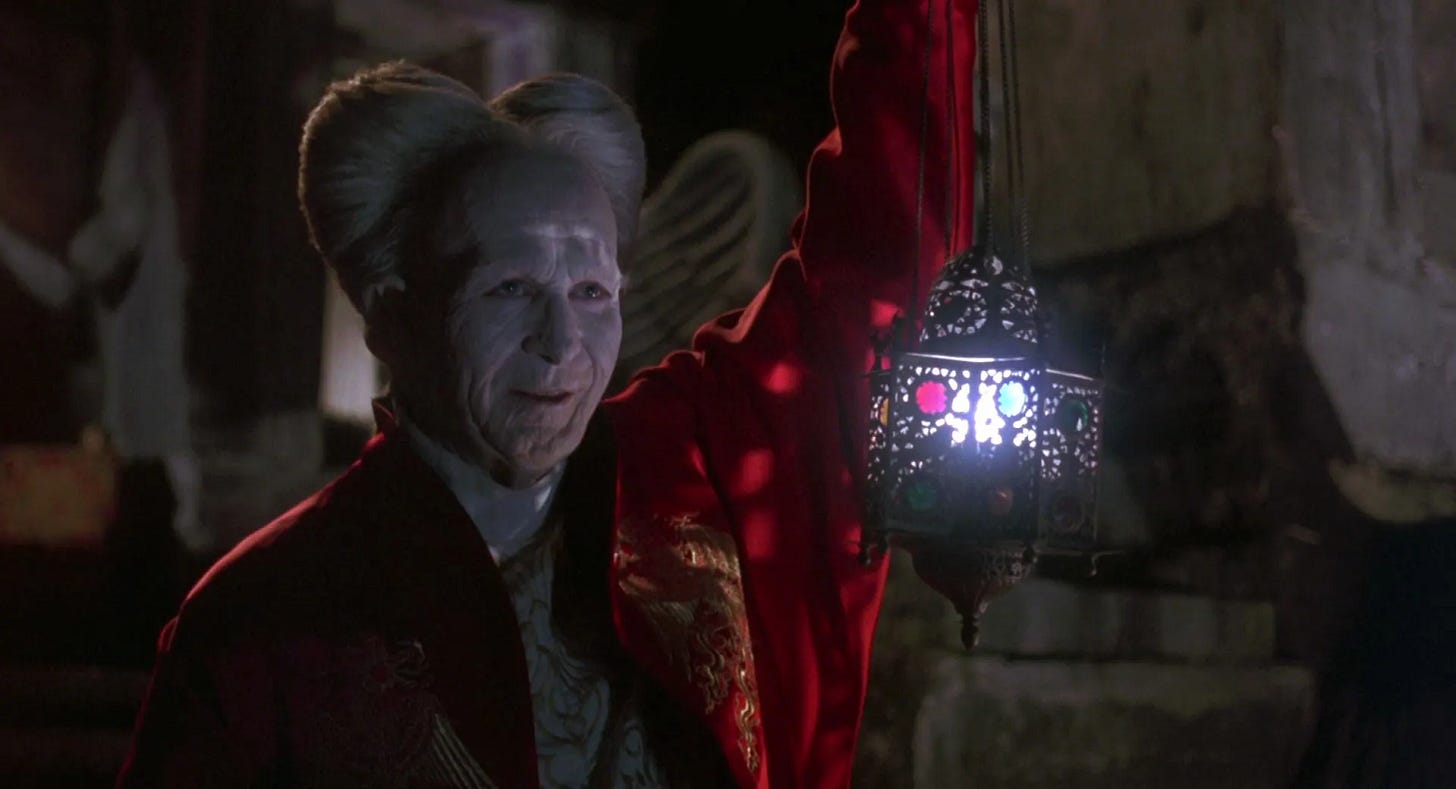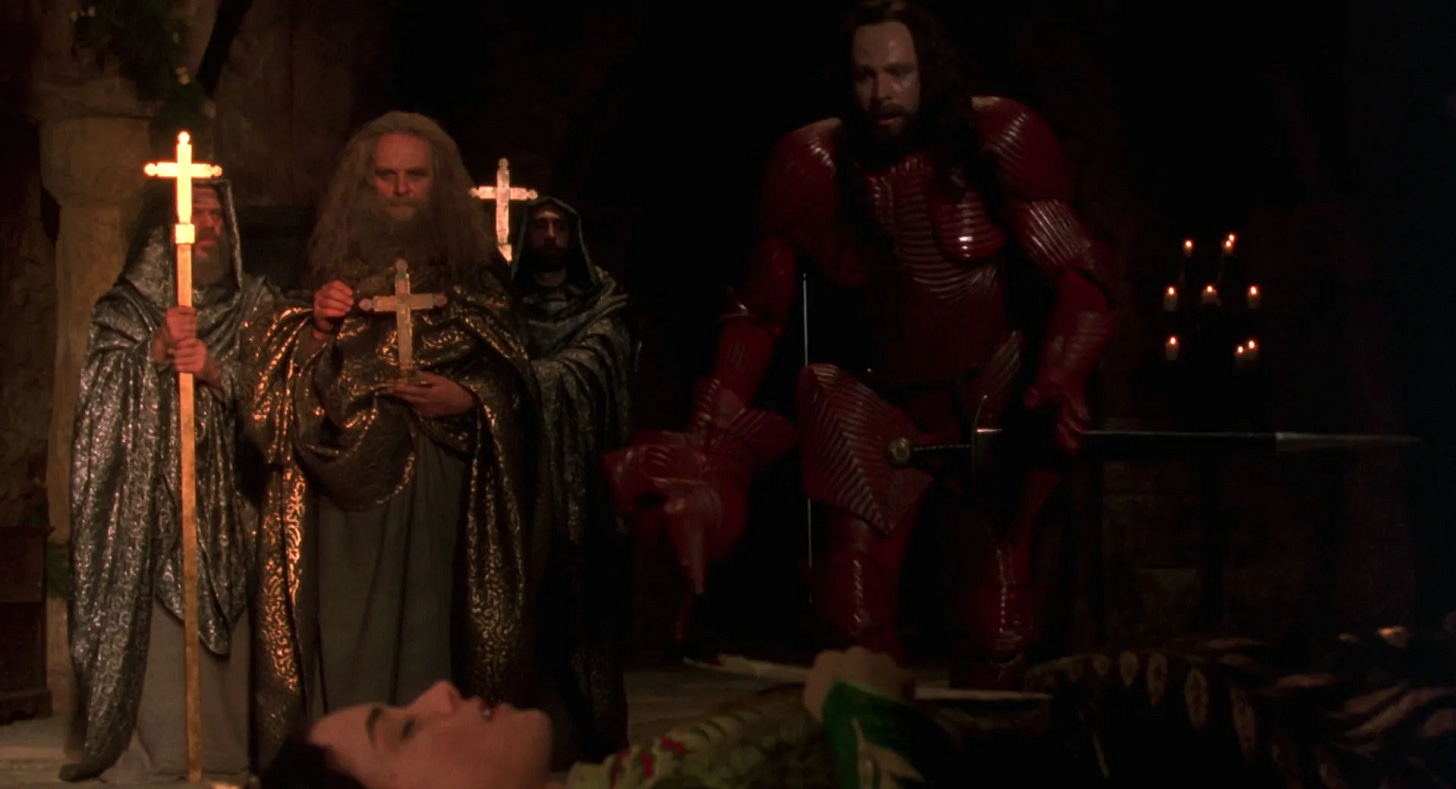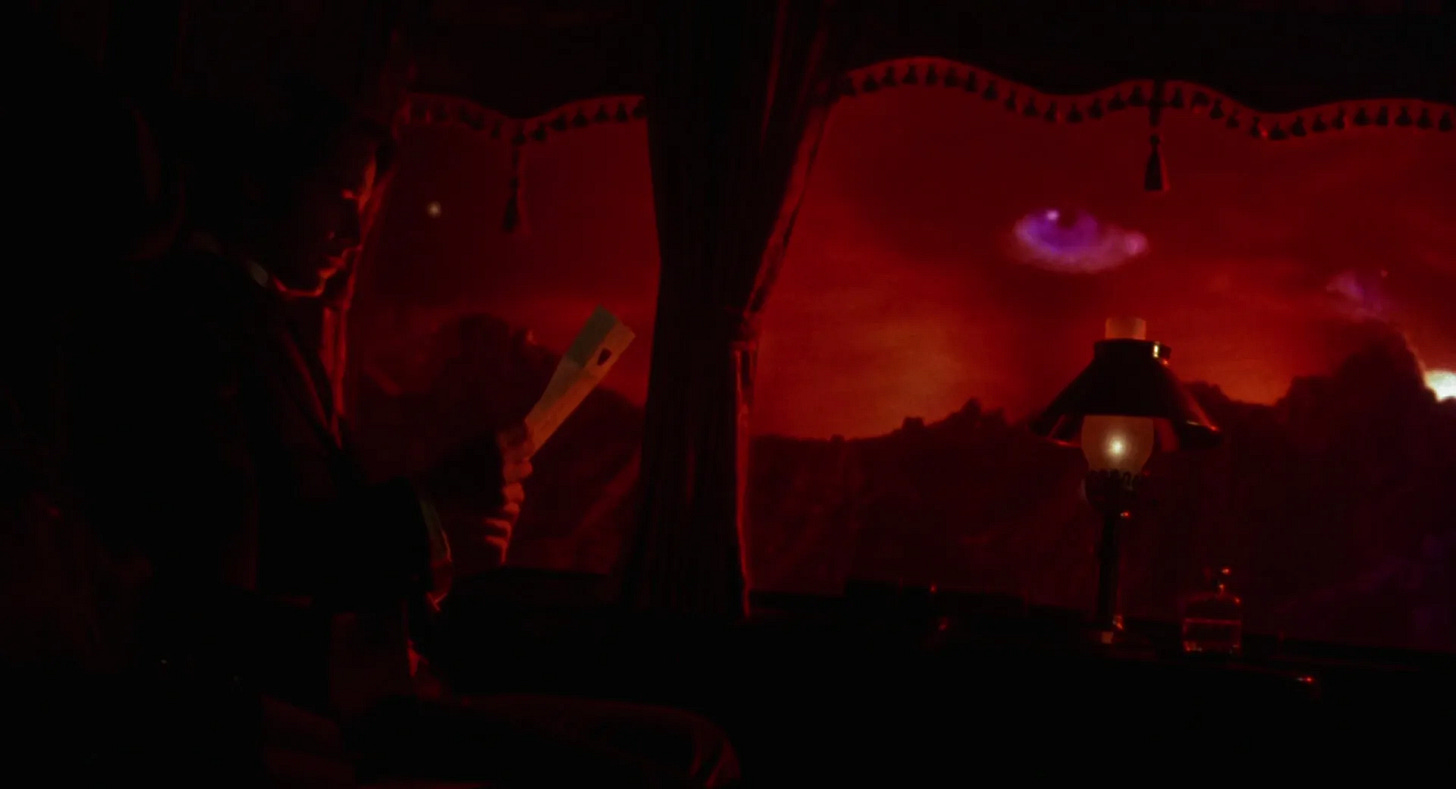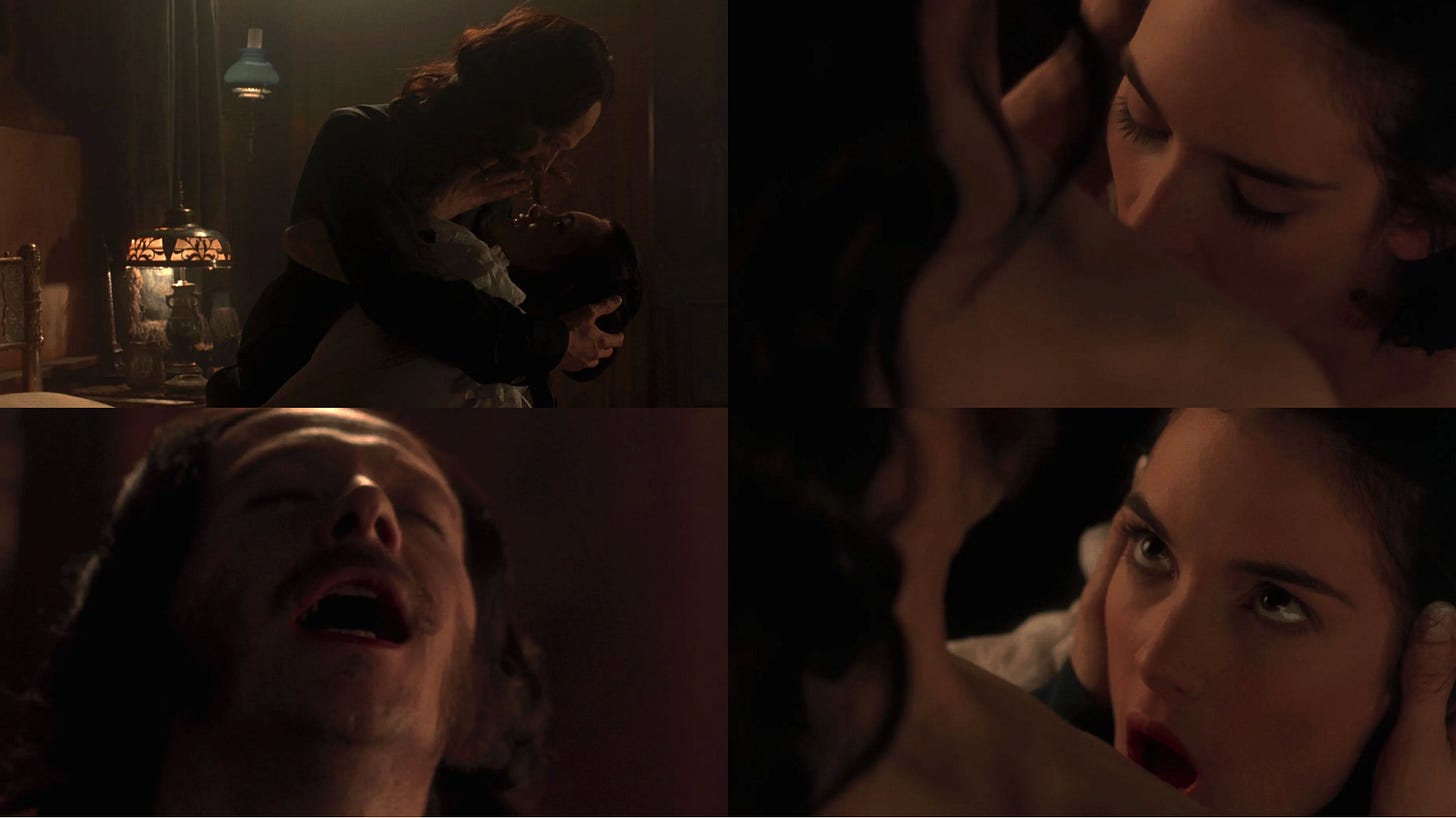Review: "Bram Stoker's Dracula" is Coppola's expressionistic masterpiece
Movie of the Week #10 is a beautiful nightmare
Welcome to Movie of the Week, a column where we take a look back at a classic, obscure, or otherwise interesting movie each and every week for paid subscribers. It usually publishes on Wednesday, but I pushed it to Friday this week to make room for the review of Coppola’s much-anticipated MEGALOPOLIS - so be sure to read that if you haven’t already. And follow this link for more details on everything you get subscribing to Fade to Lack!
I had two questions after I finally watched Francis Ford Coppola’s Bram Stoker’s Dracula for the first time earlier this year:
1) How in the name of Christ did a movie this unapologetically weird, this flagrantly sexual and delightfully deviant and gloriously artificial, ever get made in Hollywood in 1992, or any other year for that matter? And –
2) Why aren’t we all talking about it every minute of every day?
Coppola’s film is a truly astonishing piece of big-budget myth-making, the rare kind of experience where my jaw hit the floor from the very first frames – an opening of medieval carnage that takes its theatrical, horrifically colorful cues from Akira Kurosawa’s Ran (1985) – and never closed again for the next two hours. Dracula’s dreamlike visuals are much more akin to the silent film greats of the 1920s and 30s than almost anything made for wide commercial release since; I thought not only of the obvious German Expressionist comparisons to F.W. Murnau’s Nosferatu (1922) or Robert Wiene’s The Cabinet of Dr. Caligari (1920), but also Abel Gance’s Napoleon (1927) and Mário Peixoto‘s Limite (1931), or experimental films of the period like The Life and Death of 9413: a Hollywood Extra (1928). The thrill of watching masterpieces from that era is their relative lack of inhibition; the cinema was still, quite literally, new, and there were artists working on almost unfathomably massive canvases treating celluloid as a space of experimentation, a laboratory for inventing a new visual language of mass communication. That is the register Coppola’s Dracula operates on, banishing a century of conventions from its vocabulary and treating every shot as an opportunity to try something new, to communicate a mood or an emotion differently than other artists had before. That Coppola does this while re-telling one of cinema’s most oft-adapted pieces of source material makes it all the more thrilling, because the gap between what we expect – all the other versions of Dracula we have watched, or simply absorbed through cultural osmosis – and what we actually see is a daunting, yawning chasm.
The basic diegetic foundation of the image is constantly in doubt, as the hypnotic powers of Dracula seem to emerge from the camera to affect the entire look and feel of the movie. His shadow acts independently of his figure, his eyes protrude ominously from the sky itself, and the whole world around him takes on these grand, theatrical gesticulations. There is no fear of artifice in Coppola’s Dracula, but a wholehearted embrace of its possibilities; the film is a visual procession that feels like it’s marching straight out of someone’s id, raw and unfiltered, the grand images one might imagine while reading the book, or, perhaps more accurately, while dreaming about it afterwards.
The result is a film of such overwhelming visual invention that one could strip every bit of sound design out but the music (an incredible score by Polish composer Wojciech Kilar, that sounds like it’s emanating from a grand, imposing cathedral), slap in some intertitles for the most essential dialogue, and the end result would work more or less perfectly as a silent film (given the accent work by the American leads, some might argue it would work even better). Sound is of course a vital aspect of filmmaking, and there are all manner of films and film styles that would not work without synchronized sound; but at the same time, it is difficult to appreciate how many movies use sound as a crutch, as an escape valve from having to do the hard work of communicating ideas visually, until one sees a work like Bram Stoker’s Dracula, obsessively devoted to using every inch of the frame to assault the senses.
I do not think it a stretch to call Coppola’s film a real masterpiece of cinematic craftsmanship, and it is no surprise to see so many big names among the film’s crew, from the great Michael Ballhaus, whose praises I sang writing about Prince’s Under the Cherry Moon back in July, as Director of Photography, to Thomas Sanders on Production Design (he worked on many notable films, but one of the last before he died was Guillermo del Toro’s criminally underrated Crimson Peak, which is in many ways a successor to Coppola’s efforts on Dracula) and Nathan Crowley on Art Direction, years before he would become a six-time Oscar-nominated Production Designer (five of those for collaborations with Christopher Nolan). Eiko Ishioka’s Oscar-winning work on Costume Design is legendary in its own right; a visual artist in a wide array of media who only worked on a few films in her lifetime (including fellow film brat Paul Schrader’s Mishima: A Life in Four Chapters in 1985), Ishioka brought such a unique sensibility to Dracula that her costumes remain the film’s greatest cultural legacy, impacting how these characters are portrayed to this day. That nightmarish red armor worn by Gary Oldman’s Dracula in his human form is my personal favorite, but one could fill several articles focusing on the various ensembles worn by the title character alone.
Where most of these crafts positioned were filled by once or future industry veterans and artistic titans, the special effects are a different story entirely. The legend goes that Coppola insisted against CGI (just coming into vogue in 1992, with Terminator 2 having changed the game a year earlier and Jurassic Park set to break the dam a year later), instead wanting to experiment with tools and techniques from decades earlier. This brought him into conflict with the VFX professionals he initially hired, so Coppola fired that team, brought on his son Roman Coppola (then in his mid-twenties, years before he would make a name co-writing Wes Anderson movies and directing music videos), and the two proceeded to create some of the most seamless and hallucinogenic imagery ever seen on screen, completely through practical in-camera effects. Roman also did second-unit direction, and the entire adventure was the younger Coppola’s first time ever filling these roles on a motion picture. That’s astonishing, considering just how singular the film’s visual style is, but one also imagines it was liberating to have someone unburdened by years of experience in this particular position, given the wholly unusual nature of the elder Coppola’s visual ambitions.
I am probably preaching to the converted in declaring the craft of Bram Stoker’s Dracula extraordinary; that much is, after all, self-evident. And while I think a great stylistic exercise simply for the purpose of aesthetic experimentation and invention is still absolutely worthy of praise, I want to push back against the idea I’ve heard repeated in various forms over the years that Coppola’s Dracula emphasizes style above, or at the expense of, substance. Putting aside my own annoyance with the idea that ‘style’ and ‘substance’ can ever truly be separated – style, even or especially in its absence, always says something – I think this is an incredibly smart and oftentimes provocative take on the material. As evinced by the presence of the author’s name in the title, Coppola’s film returns to Bram Stoker’s original text to adapt narrative elements typically excised from stage and screen depictions; but just as crucially, it also engages with a century of scholarship and paratextual extensions of Stoker’s story to lay bare the fundamentally psychosexual nature of the story. This is ‘Bram Stoker’s Dracula,’ closer in many ways to the letter of the novel than prior adaptations, but it is also a film about the ways culture has absorbed, extended, and transformed ‘Bram Stoker’s Dracula,’ its haunting (or perhaps haunted) dreamlike imagery arising from the collective unconscious that has formed around the book.
A pithy, but accurate, way of describing Coppola’s film would be as ‘Film School Dracula,’ not only for all the pieces of film history it nakedly draws upon, but for the strong psychoanalytic bent to the storytelling, the way it explores interiority and the id and the various unconscious sexual drives that grow closer and closer to the surface the deeper we delve into the nightmare. By the time we have a literal ejaculation of blood all over the screen at the height of the sequence intercutting between Lucy’s vampiric transformation and Jonathan and Mina’s wedding, or arrive at a scene where Winona Ryder passionately sucks the blood from Gary Oldman’s chest, the film has become at least mildly pornographic. If the erotic nature of the vampiric metaphor was ever truly subtext, Coppola refuses to let it stay there, hoisting it up into the topmost layer of the text and forcing us to confront the way the vampire has, over decades of extension and reinterpretation, become essentially sexual.
The film’s (and the book’s) Victorian setting is no accident or happenstance; this is a story of repressed people – particularly women, who are the characters Coppola far and away shows the most interest in – unrepressing themselves on the margins of society. One of the most shocking gestures of this adaptation is that the characters need not necessarily be punished for it. The movie is more sympathetic to Dracula than it appears at first glance, and Mina’s love for him is not a byproduct of hypnosis, nor is it ultimately rejected; it is in fact consummated, in sex and in blood. The film is completely comfortable acknowledging that the violence and the eroticism of the vampiric myth are inseparably intertwined, how the excesses in both directions tear asunder the buttoned-up world the human men in the story want to keep closed. And in these ways, the film also opens itself up to any number of queer readings; I am particularly struck at how Coppola links the heterosexual marriage between Jonathan and Mina to extreme violence, in both the aforementioned intercutting with Lucy’s transformation and the generally reluctant way Ryder plays the scene, while the ‘forbidden’ vampire/human romance between Mina and Dracula is allowed real passion.
Are there nits to pick with Bram Stoker’s Dracula? I suppose. Keanu Reeves and Winona Ryder both sport laughably poor British accents, but then, nobody (with the possible exception of Cary Elwes) is speaking with anything approaching their native accent in this movie. I am quite positive Gary Oldman’s outrageous faux-Romanian accent is equally erroneous, but since Dracula is essentially fantastical, we let it pass. The truth is everyone here exists in a fantasy, and to me, the voice work disappears into the sheer theatricality of the mise-en-scene, another piece of artifice that tells us again and again we are not watching reality, but a series of imagistic representations of the workings of the human libido. In any case, while I can understand complaints about Reeves – who is, in fairness, being asked to underplay things next to actors who are swinging for the fences – to reject Ryder’s performance on account of the accent would be to look past a disarmingly soulful physical performance, a complete creation of a character who evolves and changes and is ultimately the heart of the picture. She is outstanding from first to last.
I love this movie. It is an arresting, playful work of cinematic art that thumbs its nose at expectations and practically dares the viewer to leave their assumptions at the door, to allow oneself to slip into a state of unrepressed revel sufficient enough to ride its insane, gonzo wavelength. While the works he is best known for – The Godfather, The Conversation, Apocalypse Now – tend more towards naturalism (though with their own flourishes of theatricality), Coppola has on several occasions tried to mount grander, fabulously expressionistic productions, almost always to his career’s detriment. 1982’s not-quite-a-musical One from the Heart so thoroughly bankrupted Coppola that he spent the entire decade digging his way out of the hole; The Godfather Part III – which, as I established last week, is terrible – was the final step in that long climb back to solvency, and it says a lot that Dracula is where he immediately put his chips next. In this case, the stars aligned, and his experiment was met with both critical and commercial success. That has mostly eluded him in the decades since, but if Coppola has conjured one-tenth of the bizarre beauty he achieved on Dracula with this week’s long-awaited Megalopolis, I will frankly be beside myself with joy.
NEXT WEEK: We kick off October with an all-time great horror classic, celebrating its 40th anniversary this year: Wes Craven’s A NIGHTMARE ON ELM STREET! Here’s a look at the full line-up for October!
Read the book 200 Reviews by Jonathan R. Lack in Paperback or on Kindle
Subscribe to PURELY ACADEMIC, our monthly variety podcast about movies, video games, TV, and more
Like anime? Listen to the podcast I host with Sean Chapman, JAPANIMATION STATION, where we review all sorts of anime every week. Watch on YouTube or Subscribe wherever you get your podcasts.









